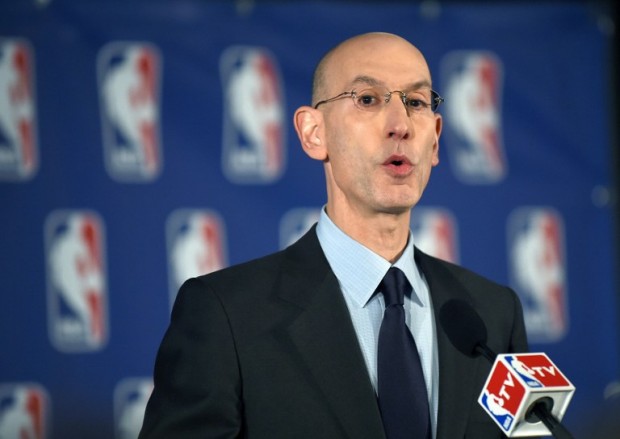
In this April 29, 2014 file photo, NBA Commissioner Adam Silver holds a press conference in New York. Sporting goods giant Nike reached an eight-year deal June 10, 2015 to become the exclusive on-court apparel provider for the NBA. The contract takes effect in the 2017-2018 season, replacing a deal between the National Basketball Association and Adidas, which expires after the 2016-2017 season. “This partnership with Nike represents a new paradigm in the structure of our global merchandising business,” said Silver. AFP FILE PHOTO
LAS VEGAS — Changes to the NBA playoffs are almost certainly coming.
Changes to the league’s much-discussed moratorium and Hack-a-Shaq aren’t, at least not now.
After meeting with the league’s Board of Governors on those and other topics Tuesday, NBA Commissioner Adam Silver said that – as expected – the league is leaning toward eliminating any protection for division winners in playoff seeding going forward and instead placing the eight teams on the Eastern and Western Conference brackets based solely by record.
There was no vote Tuesday, though one is expected soon.
“It’s my expectation that that change will be adopted before the beginning of this coming season,” Silver said.
In the past, division winners have been assured of a top-four seed. For example, this past season, Memphis and San Antonio would have been up one spot to No. 4 and No. 5 in the West bracket, while Portland – the Northwest Division winner which had four fewer wins than the Grizzlies and Spurs – would have fallen from No. 4 to No. 6.
“We wanted all the owners to have an opportunity to go back and discuss that recommendation with their general managers and their coaches,” Silver said.
It seems like an easy fix.
The moratorium issue, that one is stumping everyone.
The league has an annual window starting July 1 where deals can be agreed to, but not finalized while the salary numbers and other financial matters for the coming year are being crunched. And it got tons of attention this year when DeAndre Jordan committed to the Dallas Mavericks, then changed his mind and stayed with the Los Angeles Clippers.
Jordan broke no rules; his commitment was nonbinding.
“I’m not sure it was his proudest moment either,” Silver said.
Changing the moratorium was discussed, and Silver said no one had a good solution. Some ideas bandied about in recent days include having a memo of understanding that could be executed to essentially lock in the commitment while the budgets for the new league year are still being worked out, or simply shortening the moratorium.
“It was not a great look,” Silver said. “It’s not what we want to see happen in the moratorium period. It wasn’t created so players could enter into in essence oral agreements only to have those agreements superseded by binding agreements. Of course, under our collective bargaining agreement, there’s no dispute that only a signed agreement is binding. But there was a breakdown in the system to a certain extent.”
In other news Tuesday:
Escape Routes
The league is looking into not only widening the escape routes – the path next to the basket supports where players can decelerate in while hopefully not crashing into photographers and fans – but also adding a second one of those on each side of a basket for next season.
Players have long complained about the collisions into photographers, and the issue became a huge story in the NBA Finals when LeBron James of the Cleveland Cavaliers crashed into a cameraman and got a sizable cut on the size of his head.
Hack-a-Shaq
While it seems nobody likes Hack-A-Shaq – the mechanism where teams foul a player intentionally to send him to the line knowing the odds aren’t high that he’ll make both free throws – it might still be part of the NBA world.
Ratings for NBA games don’t show that people aren’t watching because of Hack-a-Anyone. And it might serve as a signal to young players about the importance of making foul shots.
“There is a sense, especially from the basketball people, that it would be sending the wrong message to the larger basketball community – particularly youth basketball – to de-emphasize the need for guys to hit free throws,” Silver said.
Bucks Arena
Silver said the notion that the Milwaukee Bucks could move to Las Vegas “is not realistic in the short term.”
The Wisconsin Senate could vote as early as Wednesday on a plan to direct $55 million in state money as part of the public financing plan for a new arena, one where the Bucks’ current and former ownership have committed to giving another $250 million toward.
“My hope is that team is not going to relocate,” Silver said.
Countdown Clock
The league has had a 90-second countdown clock in arenas to ensure that games start on time after starting lineups are introduced, and the same thinking may soon be applied to stoppages between quarters and for timeouts.
It’s believed that a little more vigilance in that respect would shorten games slightly.